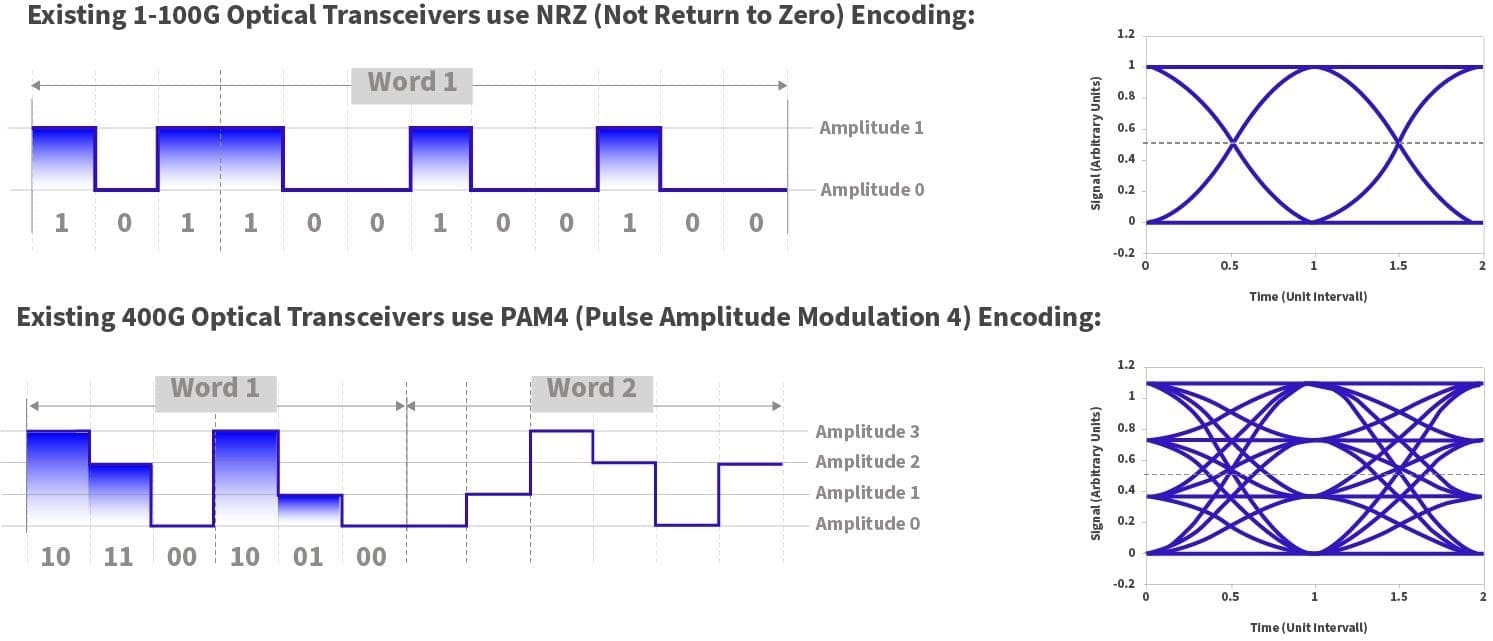PAM4 vs NRZ in Optical Ethernet
With the increasing demand for optical equipment to deliver bigger data rates, new technologies are emerging. For a long time, NRZ (Non-return-to-Zero) was pushed to its limits to maximize existing hardware. However, this could only go so far. Pulse Amplitude Modulation 4-level (PAM4) emerged in the optical network market as a more advanced encoding technique that allows for greater data rates. To fully understand the differences, let’s take a closer look at both modulation schemes in optical equipment and how they work. We’ll answer the questions “What is NRZ?” and “What is PAM4?”.
What is NRZ?
or Non-return-to-Zero is a simple binary modulation scheme that represents data using two voltage levels, a logical “1” represented by high voltage level, logical “0” by low. Such modulation is easy to achieve but limits the amount of data possible to be transmitted in a single wavelength.
What is PAM4?
PAM4, or Pulse Amplitude Modulation 4-level, is a more advanced modulation technique that encodes data using four distinct amplitude levels. This effectively doubles the data rate for a given bandwidth compared to NRZ.
NRZ vs PAM4
Now that we understand the inner workings of each data modulation technique, let’s compare them.
Data Rate and Bandwidth Efficiency
The primary value of optical equipment is its data rate and bandwidth efficiency. As previously mentioned, PAM4 modulation can effectively double the amount of data transmitted in a single bandwidth compared to NRZ modulation.
PAM4 vs NRZ Signal Spectrum
In signal spectrum analysis, NRZ signals contain significant high-frequency components, requiring more bandwidth to transmit higher data rates. On the other hand, PAM4 modulation compresses the signal spectrum by transmitting more bits per symbol, resulting in better bandwidth utilization and allowing for higher data rates without proportionally increasing the required bandwidth. For example, 100Gb of data in an NRZ-modulated module requires four different bandwidths, while a PAM4-modulated 100G module can suffice with just two.
Signal-to-Noise Ratio (SNR)
The higher the SNR, the fewer errors might occur while using a module. Generally, NRZ modulation modules have a higher SNR because there are only two levels to distinguish in the signal, making it less susceptible to noise and easier to detect. In terms of error proofing, NRZ is better than PAM4 modulation. Since PAM4 uses four levels crammed into a single bandwidth, the SNR is lower, increasing the chance of errors. This requires higher costs for PAM4 technology implementation due to the need for sophisticated error correction and signal processing techniques.
Conclusions
PAM4 modulation is the next advancement step towards higher data rates in optical communications, despite challenges like reduced SNR, complexity, and power consumption. The positive aspects, such as higher data rates, improved bandwidth efficiency, and scalability, ensure the continued development and usage of PAM4 technology in the race for higher data stream speeds. NRZ will remain a cheaper alternative for less demanding data rate segments, providing higher redundancy and lower prices.
If you are interested, check out our portfolio of optical modules using PAM4 modulation:


